Laser Treatment for Sun Damage
Sun damage is one of the most common and noticeable signs of aging on the skin. As we grow older, damage from unprotected sun exposure accumulates, leading to pigmentation issues and sun spots, also known as age spots, solar lesions, or liver spots. Additionally, sun damage can lead to photoaging, an early form of skin aging characterized by fine lines, wrinkles, and uneven skin texture. It can appear on any part of the body exposed to the sun, but is most often seen on the face, neck, chest, arms, back, and hands. Fortunately, there are many treatment options available to reduce sun damage and improve skin pigmentation. Dr. Green provides a range of lasers at her private NYC dermatology practice to help eliminate sun damage and promote a clearer, more radiant complexion.
Lasers have become increasingly popular for treating sun damage because they can rejuvenate the skin with minimal downtime and few side effects. The Fraxel laser is highly effective at removing sun damage, pigmentation, and sunspots from the face and other areas, offering comprehensive rejuvenation. The Alex Trivantage laser is ideal for targeting specific sun spots. The Clear + Brilliant laser, often referred to as a “mini-Fraxel,” gradually reduces sun damage and pigmentation, has minimal downtime, and is safe for all skin types and tones. These lasers use different technologies to eliminate pigmentation and promote clear, smooth skin. When undergoing laser treatment for sun damage, it’s essential to consult a board-certified dermatologist, such as Dr. Green in New York City, to ensure the treatment is safe and effective for your specific skin type and tone.
Dr. Michele Green is a board-certified dermatologist with over 25 years of experience treating patients with the latest cosmetic treatments, including Fraxel, Clear + Brilliant, and Alex Trivantage lasers. Thanks to her expertise and commitment to her patients, Dr. Green is consistently recognized as one of NYC’s top dermatologists by Castle Connolly, Super Doctors, New York Magazine, and The New York Times. She adopts a holistic approach to cosmetic dermatology, personalizing each patient’s treatment plan to include a unique combination of in-office procedures and specially formulated skincare products tailored to their specific skin concerns and aesthetic goals. When you consult with Dr. Green at her private dermatology practice on Manhattan’s Upper East Side, she will collaborate with you to develop a personalized treatment plan tailored to your skin type, needs, and tone, helping you achieve a healthy, clear, and radiant complexion that lasts.
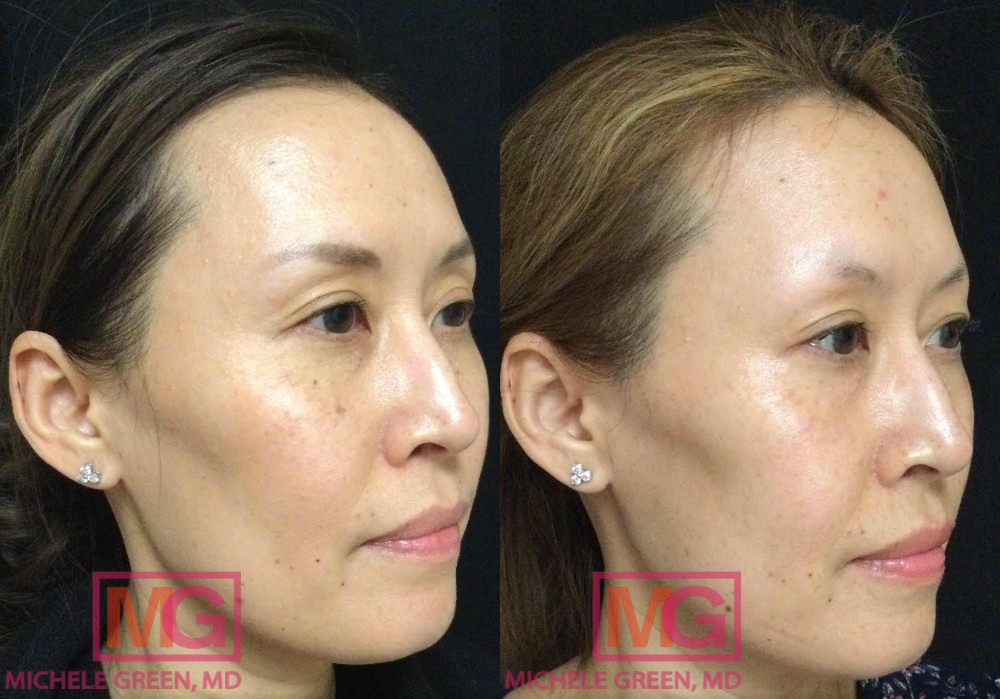
What is sun damage?
Sun damage refers to harm to the skin caused by repeated, unprotected sun exposure that commonly appears as pigmentation on the skin. Ultraviolet (UV) radiation from the sun damages the skin, prompting it to produce excess melanin as a protective response. Sunspots, also known as age spots, solar lentigines, and liver spots, are flat, brown spots that develop from prolonged exposure to the sun. Freckles are small tan or brown spots that often appear during childhood. Anyone can develop freckles, although they are more common in people with lighter skin and blonde or red hair. Sun damage can also trigger or worsen melasma, a chronic skin condition marked by brown or gray patches on the face. Several factors contribute to the development of melasma, with sun exposure and hormonal changes being the two primary causes. Since sun exposure is a key factor, melasma can appear on any part of the body exposed to significant sunlight.
Additionally, sun damage can also damage collagen and elastin fibers in the skin, resulting in photoaging, or premature skin aging, and the development of fine lines, wrinkles, and uneven skin texture and tone. The best way to avoid skin damage from the sun is to take preventive measures, which include consistently applying sunscreen with an SPF of at least 50 when you are outside and reapplying every 90 minutes. Additionally, wearing a wide-brimmed hat and sun-protective clothing, or staying indoors when the sun is at its most intense, can also help prevent sun damage. If sun damage has occurred, Dr. Green offers a wide range of non-invasive treatment options to eliminate sun spots and discoloration, achieving a clear complexion.
Can lasers remove sun damage? Does laser treatment remove sun spots?
Yes! Lasers are among the most popular treatments for sun damage because they effectively address it with minimal downtime and few side effects. Lasers utilize light energy to target melanocytes, the skin cells responsible for producing melanin. When these cells absorb the light, the pigmented cells break apart, and the body then absorbs and clears the pigment from the skin. Non-invasive lasers can eliminate excess melanin pigmentation without harming the surrounding skin, resulting in reduced side effects and a shorter recovery time.
Some lasers also boost collagen production, a protein essential for maintaining smooth and firm skin. As we age, collagen levels decrease, and repeated sun exposure can damage collagen fibers, speeding up this decline. Lasers can stimulate collagen production deep within the skin, resulting in a smoother, more even skin texture.
What is the best laser treatment for sun-damaged skin?
There is no single laser that is the best for treating sun damage. Each laser employs different technologies and methods to target sun-damaged skin. The type of laser most suitable for your skin will depend on your specific skin type, tone, and the extent of your skin concerns. When selecting a laser treatment, it is crucial to consult with a board-certified dermatologist, such as Dr. Green, to ensure the treatment matches your particular skin needs. Dr. Green has over 25 years of experience providing non-invasive laser treatments for sun damage and will select the best laser or combination of lasers to help you achieve clear, sun-damage-free skin.
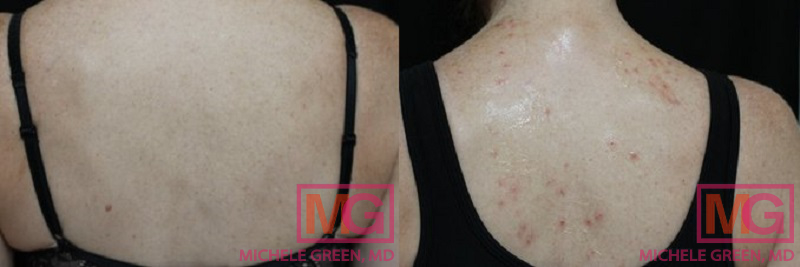
Non-invasive laser treatments to address sun-damaged skin at Dr. Green’s dermatology office
Fraxel Laser for sun damage
The Fraxel Dual laser is often referred to as a “magic eraser” because it can effectively treat a range of skin issues, including sun spots, discoloration, sun damage, fine lines, wrinkles, acne scars, and uneven skin texture. It has two wavelengths: a 1927nm Thulium laser setting for treating sun spots and sun-damaged skin, and a 1550nm Erbium laser setting for addressing fine lines and uneven texture. When using the 1927 nm wavelength, the Fraxel laser targets specific chromophores in the dermis to reduce pigmentation and eliminate sun and age spots. It utilizes non-ablative laser technology with microscopic columns that penetrate deeply into the skin, treating only a portion of the tissue at a time, which helps protect the surrounding area and accelerate healing. There is minimal downtime; patients typically experience mild redness, similar to a sunburn, for up to 48 hours, along with 3 to 7 days of peeling, during which the treated skin may feel rough. Most patients require at least three treatments, spaced approximately one month apart, to achieve optimal results.
AlexTrivantage Laser for sun spots
The AlexTrivantage laser is a Q-switched laser that treats discrete, localized sun spots on the skin. This laser utilizes three distinct wavelengths to treat benign pigmented lesions: 532 nm, 755 nm, and 1064 nm. These wavelengths are absorbed into the body as light energy, then absorbed by the melanin-rich lesions, breaking down the pigmentation and allowing new, healthy skin cells to form on the surface. After treatment, patients will develop a small scab in the affected area, which will naturally heal and fall off, leaving behind clear, healthy skin. Depending on the severity, patients typically only need one treatment and can begin to see results within one to two weeks after their treatment session. The Alex Trivantage can be used on various areas of the body, including the face, neck, chest, arms, back, and hands.
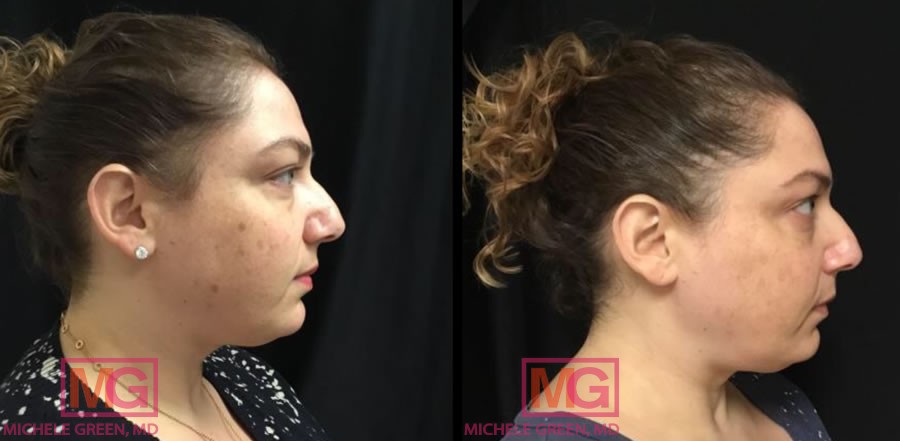
Clear + Brilliant for fine lines and age spots
The Clear + Brilliant laser is a non-invasive fractional laser used to treat sunspots, age spots, sun damage, fine lines, enlarged pores, acne scars, and uneven skin tone and texture with no downtime. Clear + Brilliant uses fractional laser energy to create thousands of tiny injuries in the skin, triggering the body’s natural healing processes, including skin cell renewal and collagen production. This method helps exfoliate superficial skin cells containing sun and age spots, making way for new, healthy skin with an even tone and texture. The Clear + Brilliant laser also has a second handpiece called the Perméa, which is effective for treating pigmentation, brown spots, sun spots, and melasma. The Perméa handpiece utilizes a 1927nm wavelength that enhances the absorption of pigmentation. The procedure is safe for patients of all skin types and tones. After a series of treatments, patients can expect a clear, radiant complexion.
Is laser treatment good for sun-damaged skin?
Yes! Laser skin resurfacing treatments can be an excellent option for addressing sun-damaged skin. Non-invasive laser therapies, such as Fraxel, Alex-Trivantage, and Clear + Brilliant, help remove sun damage and dark spots with minimal downtime and side effects. However, laser treatment might not always be suitable depending on your skin tone and the type of hyperpigmentation present. Patients with darker skin tones are often not ideal candidates for these laser procedures, as the lasers can misinterpret their skin tone as pigmentation, leading to adverse effects like hyperpigmentation, hypopigmentation, and scarring.
Additionally, patients with melasma should avoid laser treatments for their pigmentation. Melasma is a chronic skin condition characterized by brown or gray patches on the skin. While melasma is often triggered or worsened by sun and UV exposure, the exact cause of the condition remains unknown. Melasma should not be treated with lasers, as the heat from the lasers can deepen the pigmentation into the skin, making it worse and more difficult to treat later. To the untrained eye, distinguishing between dark spots on the skin and melasma or sun spots can be challenging, so consulting a board-certified dermatologist, such as Dr. Michele Green, is crucial for effective treatment. During your consultation, Dr. Green will assess your pigmentation and medical history to determine whether it is caused by melasma or sun spots, and develop a personalized treatment plan to help you achieve clear, sun-damage-free skin that lasts.
Non-laser cosmetic procedures for melasma and hyperpigmentation
Chemical peels
A chemical peel is a non-invasive exfoliating treatment in which a chemical solution is applied to the skin’s surface to remove the top layer, sloughing off dead skin cells and debris to stimulate collagen production and reveal healthy, new skin cells on the surface. Trichloroacetic acid (TCA) peels are effective for improving skin tone and texture, addressing issues such as acne scars, active acne, enlarged pores, fine lines, hyperpigmentation, and other signs of aging. Multiple sessions are often needed for optimal results. TCA peels are not recommended for people with darker skin tones because they have a higher risk of hypopigmentation, post-peel discoloration, and hyperpigmentation.
Cosmelan Peels for melasma
The Cosmelan peel is a professional-grade chemical treatment specifically designed to target melasma and other types of hyperpigmentation. It accelerates skin cell renewal to minimize melanin buildup, prevents pigment from moving to the skin’s outer layers, and reduces melanin production within melanocytes. The process starts with Dr. Green carefully applying the Cosmelan 1 mask, which is left on for a duration tailored to the individual’s skin tone and the severity of discoloration. After this time, patients should gently remove the mask at home using a mild cleanser. Patients are also advised to use the Cosmelan home kit, which includes the Cosmelan 2 depigmentation cream, a gentle moisturizer, and a broad-spectrum sunscreen to help support and extend the results. The Cosmelan peel is highly effective in reducing hyperpigmentation across all skin types and tones, including those with darker skin tones.
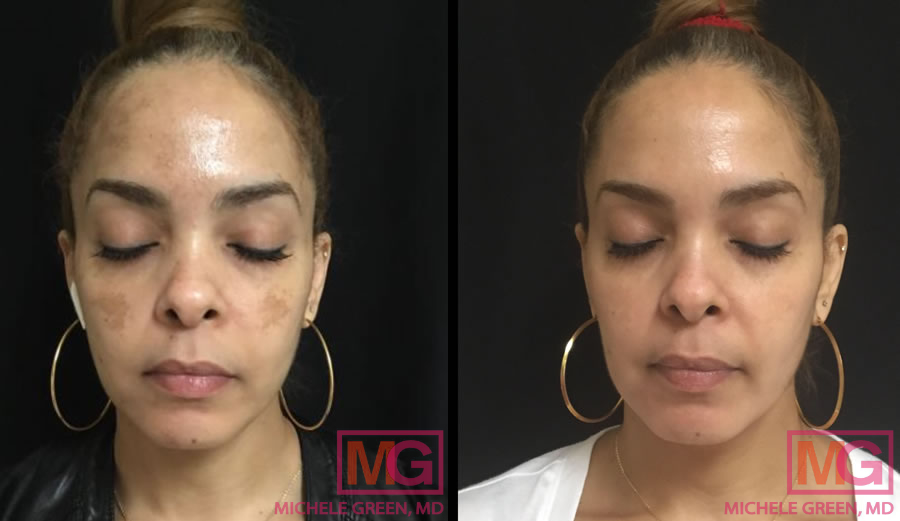
Mesopeels for sun-damaged skin
Mesopeels are specially formulated to gently yet effectively treat and reduce the appearance of skin discoloration and dark spots. They actively combat hyperpigmentation by lowering the melanin levels responsible for dark spots. Mesopeels are a great option for sensitive areas of the body, such as the inner thighs, groin, axillae, face, and under-eyes, which may be affected by hyperpigmentation. There is no downtime with Mesopeel, allowing patients to return to their daily activities immediately afterward, as long as they use sunscreen and avoid direct sunlight. Like most chemical peels, multiple Mesopeel sessions, spaced three to four weeks apart, are usually needed to achieve optimal cosmetic results.
Microneedling with depigmentation serum to reduce pigment
Microneedling, also known as collagen induction therapy, is a non-invasive skin rejuvenation procedure. It uses tiny, surgical-grade needles to create micro-injuries in the epidermis, triggering the body’s wound-healing response to boost skin cell renewal and collagen production. Additionally, it forms microchannels that enhance the absorption of specialized serums. For hyperpigmentation concerns, combining microneedling with a depigmenting serum can yield effective skin-lightening results. The serum used in Dr. Green’s private dermatology office contains powerful yet gentle agents that reduce melanocyte activity, resulting in a more even skin tone and diminished hyperpigmentation. Most patients require at least three sessions to see optimal results.
How long does it take for sunspots to go away after laser treatment?
The duration of time it takes for sunspots to be removed after laser treatment depends on the laser treatment being used. When treating isolated sunspots with the Alex Trivantage laser, sunspots can disappear after one or two treatments. When treating sunspots with fractionated lasers, such as the Fraxel or Clear + Brilliant lasers, multiple treatments spaced one month apart may be required.
Are sunspots skin cancer?
No, sunspots are harmless dark patches on the skin caused by excess melanin, resulting in discoloration. Skin cancer starts from the uncontrolled growth of abnormal skin cells. Exposure to harmful UV rays increases the risk for both sunspots and skin cancer. Since sunspots can resemble some skin cancers, it’s essential to have any new, concerning dark spots examined by a dermatologist to rule out cancer. Board-certified dermatologists, such as Dr. Michele Green, are specially trained to determine if a lesion is a sunspot or a potential skin cancer. If a lesion looks suspicious, she may perform a small biopsy for lab testing. If diagnosed as a sunspot or hyperpigmentation, Dr. Green will discuss safe and effective skin treatment to reduce the pigmentation.
Is laser treatment for sun damage permanent?
Laser treatments can permanently eliminate existing sunspots. However, they do not prevent new sunspots and sun damage from forming. To avoid new sunspots, patients should follow strict sun protection routines to shield their skin from UVA and UVB rays. Dr. Green suggests applying sunscreen with SPF 50 every morning and reapplying it every 2 hours when outdoors. Patients should also wear protective clothing such as hats, long-sleeve shirts, and lightweight pants.
How much is laser treatment for sun damage with a board-certified dermatologist?
The price of laser treatments for sun damage varies depending on location, the treatment area, the number of areas treated in a single session, the total number of sessions required, and the provider’s expertise. Usually, a board-certified dermatologist or plastic surgeon charges more than a Med Spa. Nevertheless, it is crucial to choose an expert like Dr. Green, as the risk of serious side effects—such as hyperpigmentation, hypopigmentation, burns, or scars—is much higher with an inexperienced or unqualified practitioner. During your consultation, Dr. Green will review your medical history and skin concerns to create a personalized treatment plan designed to rejuvenate your skin. The cost will be discussed during this visit.
What laser treatment is best for removing sunspots?
No laser treatment is inherently the “best” for treating sun-damaged skin on the face. The Fraxel and Clear + Brilliant lasers effectively treat sun spots that are spread diffusely across the face. In contrast, the AlexTrivantage laser is better suited for addressing individual, discrete sun spots. The most suitable treatment for sun spot removal depends on your specific skin concerns, skin type, and skin tone. When you consult with an expert, such as a board-certified dermatologist like Dr. Green, she will carefully evaluate your skin and develop a personalized plan to safely and effectively treat your sun spots.
Fraxel vs CO2 laser for sun damage
CO2 laser resurfacing is an ablative treatment that removes the outer layer of skin to address sun damage, fine lines, wrinkles, hyperpigmentation, and acne scars. The laser vaporizes the top layer, boosting skin cell turnover and activating the body’s natural healing process to increase collagen production in the treated area. Although highly effective, the CO2 laser is associated with a longer recovery time and a higher risk of side effects, including hyperpigmentation, hypopigmentation, and scarring. In contrast, Fraxel is a non-ablative laser that penetrates deeper into the skin without damaging the outer layer, resulting in skin rejuvenation with minimal downtime and side effects. Patients appreciate that Fraxel offers two settings, the 1927nm and 1550nm wavelengths, to treat sun damage, pigmentation, sun spots, fine lines, wrinkles, acne scars, and uneven skin texture.
While neither of these lasers is inherently better, the best choice for patients depends on their specific skin concerns. The CO2 laser is more aggressive and causes physical damage to the epidermis to treat sun damage, deep wrinkles, scars, and photoaging. Because this treatment is more invasive, it requires a longer recovery time and is best suited for individuals who can accommodate a recovery period. The Fraxel laser targets uneven pigmentation, mild sun damage, fine lines, and milder wrinkles. This treatment also stimulates the skin’s natural healing process, boosting collagen and elastin production. The Fraxel laser is less invasive than the CO2 laser, resulting in minimal downtime. To find the best solution for you, it’s essential to consult with a board-certified dermatologist, such as Dr. Green, to address your skin concerns and achieve your aesthetic goals.
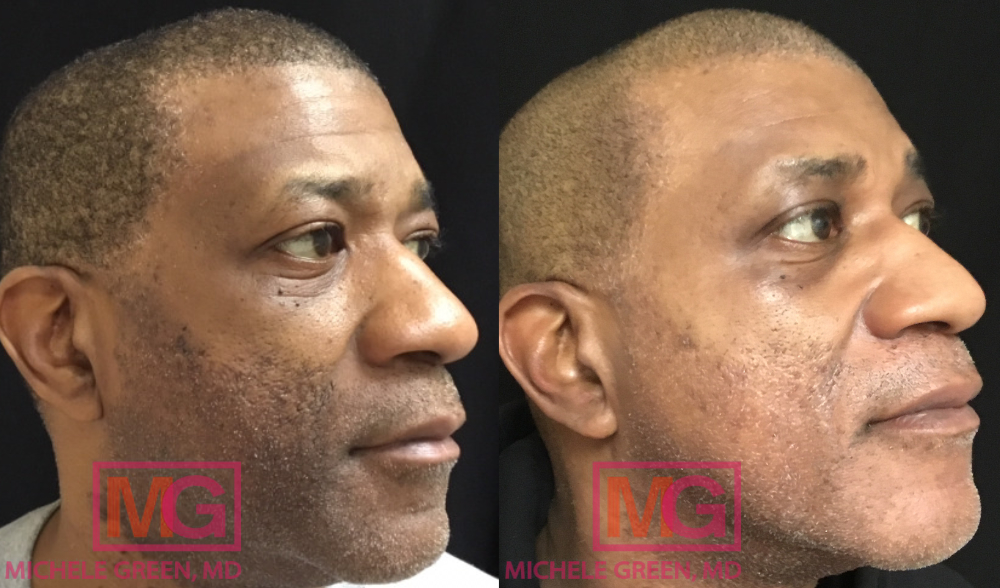
Intense pulsed light (IPL) vs laser for sun spots
Both IPL and lasers are used for treating sunspots on the skin. However, there are differences between the two. IPL is not technically a laser treatment because it does not emit a single wavelength of light; instead, it uses multiple wavelengths to scatter a flash of light onto the targeted area. This use of several wavelengths allows it to address various skin concerns, including sun spots, sun damage, skin laxity, fine lines, wrinkles, broken blood vessels, and unwanted hair. Typically, an initial series of IPL treatments is needed to achieve optimal cosmetic results. Lasers like Fraxel, Clear + Brilliant, and Alex TriVantage use a specific, focused wavelength of light to treat skin conditions such as sunspots. These lasers target melanin-rich lesions to break down the pigmentation, allowing healthier, lighter skin cells to emerge.
Determining whether IPL or laser is better for treating your sun spots can be challenging, as the best option depends on your skin type, tone, and the size of the spots. Dr. Green is a board-certified dermatologist with over 25 years of experience in treating liver and sun spots. When you meet with her at her private dermatology office on the Upper East Side, she will help you choose the most suitable treatment for your needs.
What is the best laser treatment for sun-damaged skin on the face and arms?
Some of the best non-invasive laser treatments for sun-damaged skin on the face and arms include the Fraxel laser, Alex-TriVantage laser, and Clear + Brilliant Laser. These treatment options enhance skin cell turnover, eliminating sunspots and sun damage for brighter, clearer skin. Each laser is highly effective in treating sun-damaged skin, and one treatment is not inherently better than the other. When you consult with Dr. Green, she will consider the size and scope of the treatment area, your skin tone, and your overall aesthetic goals before recommending a treatment plan that is most effective for achieving clear, radiant skin.
How to get started with the best lasers for sun damage and pigmentation
Sun damage, sunspots, and pigmentation develop from prolonged sun exposure. Although sunspots are harmless, many people seek treatment for cosmetic reasons. Fortunately, there are numerous laser options available to treat sun damage and pigmentation, enabling the achievement of clear, radiant skin. Fraxel and Clear + Brilliant are great choices for treating sun damage over a large area, while the Alex Trivantage works best for targeting isolated sun spots. These non-ablative, non-invasive lasers have minimal downtime and side effects, making it easy to attain a more even skin tone. When considering laser treatments for sun damage, it is important to consult with a board-certified dermatologist, such as Dr. Green in NYC, to ensure your treatment is safe and effective. If you’re frustrated by sunspots and pigmentation and want to rejuvenate your skin with laser therapy, Dr. Green is ready to help.
As an internationally acclaimed cosmetic dermatologist with over 25 years of experience, Dr. Michele Green utilizes the most innovative non-invasive treatments to address sun-damaged skin. Dr. Green follows a holistic approach and a ‘less is more’ philosophy when it comes to rejuvenation, consistently earning recognition as one of the top dermatologists in New York by Castle Connolly, Super Doctors, The New York Times, and New York Magazine. When you consult with Dr. Green, she will collaborate with you to develop a personalized treatment plan that includes in-office procedures and specially formulated skincare products tailored to your unique needs and situation. To schedule a consultation with Dr. Green and learn more about treating sun damage on the face and body, please call our NYC-based office at 212-535-3088 or contact us online today.
 212-535-3088
212-535-3088